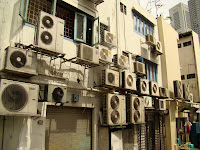There are quite a number of memorial building around the area of Boat Quay. Just imagine the amount of history these building withhold.
Dalhousie ObeliskI never come across this memorial obelisk until today. Singapore is still hiding alot of stuff from me.

A bit of history, again.
The Dalhousie Obelisk was built to commemorate the second visit of Marquis of Dalhousie to Singapore, in February 1850. Accompanied by his wife, Marquis of Dalhousie was the Governer-General of India and the objective of the visit was to consider the reduction of administrative expenditure.
However, prominent merchants and traders, who felt that Singapore's infrastructure was not keeping pace with its economic development, wanted Dalhousie to exert his influence in their favour. To win over Dalhousie, they renamed the pier by which he came ashore Dalhousie Ghaut and marked it with a commemorative obelisk. The memorial was also built to remind succeeding merchants of the benefits of free trade.
Victorial Memorial HallBuilt in the era of Victorian Revivalism, the complex started out as a town hall. Construction of neighbouring building in memory of the late Queen Victoria began in 1901. Then on 18 October 1905 it was officially opened as the Victoria Memorial Hall. Along the way, the town hall was renovated and had a unified look with the memorial hall.

In 1906, a signature clock was added and it stood in between the two building connecting them as a common corridoor. It stands a height of 54 metres and is topped by a timepiece donated by the Strait Trading Company.

Of course, the addition of the statue of our founder was moved from the Padang to the current location in 1919.
The building's purpose changed throughout the years. As a start, it was a town hall, then a memorial hall. During the Japanese Invasion, it was used a a hospital before the occupation. After the occupation, the hall was used as the venue for Japanese War Crime Trials. People's Action Party was founded in this very hall too.
In 1979, it was renamed as the Victoria Concert Hall and it was gazetted as a national monument on 14 February 1992.
Bronze Elephant From Siam
A gift from King Chulalongkorn as a token of appreciation after his stay on 15 March 1871. Siam was one of the most powerful country at that point of time.
 Supreme Court and City Hall
Supreme Court and City Hall
The place that used to hold up to the name of justice and a common place for goverment.

What I like about the Supreme Court is the statue that is above the building. With a sword and a balance on hand, the lady of justice reveals the truth and uphold the justice.























































